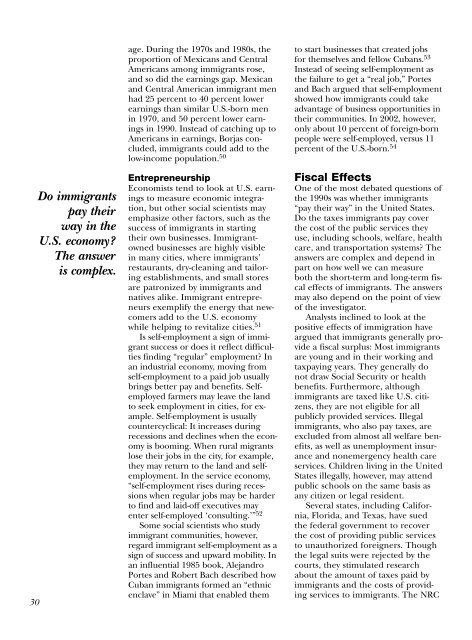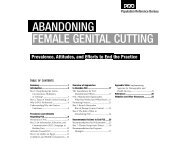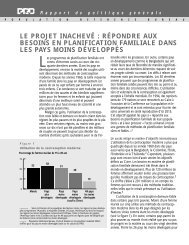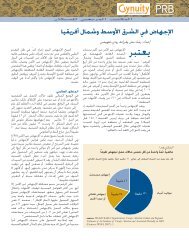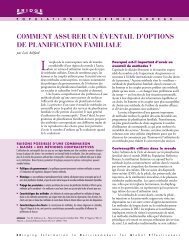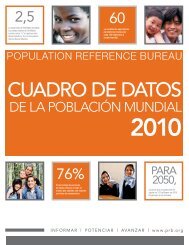Immigration Shaping America - Population Reference Bureau
Immigration Shaping America - Population Reference Bureau
Immigration Shaping America - Population Reference Bureau
Create successful ePaper yourself
Turn your PDF publications into a flip-book with our unique Google optimized e-Paper software.
30<br />
Do immigrants<br />
pay their<br />
way in the<br />
U.S. economy?<br />
The answer<br />
is complex.<br />
age. During the 1970s and 1980s, the<br />
proportion of Mexicans and Central<br />
<strong>America</strong>ns among immigrants rose,<br />
and so did the earnings gap. Mexican<br />
and Central <strong>America</strong>n immigrant men<br />
had 25 percent to 40 percent lower<br />
earnings than similar U.S.-born men<br />
in 1970, and 50 percent lower earnings<br />
in 1990. Instead of catching up to<br />
<strong>America</strong>ns in earnings, Borjas concluded,<br />
immigrants could add to the<br />
low-income population. 50<br />
Entrepreneurship<br />
Economists tend to look at U.S. earnings<br />
to measure economic integration,<br />
but other social scientists may<br />
emphasize other factors, such as the<br />
success of immigrants in starting<br />
their own businesses. Immigrantowned<br />
businesses are highly visible<br />
in many cities, where immigrants’<br />
restaurants, dry-cleaning and tailoring<br />
establishments, and small stores<br />
are patronized by immigrants and<br />
natives alike. Immigrant entrepreneurs<br />
exemplify the energy that newcomers<br />
add to the U.S. economy<br />
while helping to revitalize cities. 51<br />
Is self-employment a sign of immigrant<br />
success or does it reflect difficulties<br />
finding “regular” employment? In<br />
an industrial economy, moving from<br />
self-employment to a paid job usually<br />
brings better pay and benefits. Selfemployed<br />
farmers may leave the land<br />
to seek employment in cities, for example.<br />
Self-employment is usually<br />
countercyclical: It increases during<br />
recessions and declines when the economy<br />
is booming. When rural migrants<br />
lose their jobs in the city, for example,<br />
they may return to the land and selfemployment.<br />
In the service economy,<br />
“self-employment rises during recessions<br />
when regular jobs may be harder<br />
to find and laid-off executives may<br />
enter self-employed ‘consulting.’” 52<br />
Some social scientists who study<br />
immigrant communities, however,<br />
regard immigrant self-employment as a<br />
sign of success and upward mobility. In<br />
an influential 1985 book, Alejandro<br />
Portes and Robert Bach described how<br />
Cuban immigrants formed an “ethnic<br />
enclave” in Miami that enabled them<br />
to start businesses that created jobs<br />
for themselves and fellow Cubans. 53<br />
Instead of seeing self-employment as<br />
the failure to get a “real job,” Portes<br />
and Bach argued that self-employment<br />
showed how immigrants could take<br />
advantage of business opportunities in<br />
their communities. In 2002, however,<br />
only about 10 percent of foreign-born<br />
people were self-employed, versus 11<br />
percent of the U.S.-born. 54<br />
Fiscal Effects<br />
One of the most debated questions of<br />
the 1990s was whether immigrants<br />
“pay their way” in the United States.<br />
Do the taxes immigrants pay cover<br />
the cost of the public services they<br />
use, including schools, welfare, health<br />
care, and transportation systems? The<br />
answers are complex and depend in<br />
part on how well we can measure<br />
both the short-term and long-term fiscal<br />
effects of immigrants. The answers<br />
may also depend on the point of view<br />
of the investigator.<br />
Analysts inclined to look at the<br />
positive effects of immigration have<br />
argued that immigrants generally provide<br />
a fiscal surplus: Most immigrants<br />
are young and in their working and<br />
taxpaying years. They generally do<br />
not draw Social Security or health<br />
benefits. Furthermore, although<br />
immigrants are taxed like U.S. citizens,<br />
they are not eligible for all<br />
publicly provided services. Illegal<br />
immigrants, who also pay taxes, are<br />
excluded from almost all welfare benefits,<br />
as well as unemployment insurance<br />
and nonemergency health care<br />
services. Children living in the United<br />
States illegally, however, may attend<br />
public schools on the same basis as<br />
any citizen or legal resident.<br />
Several states, including California,<br />
Florida, and Texas, have sued<br />
the federal government to recover<br />
the cost of providing public services<br />
to unauthorized foreigners. Though<br />
the legal suits were rejected by the<br />
courts, they stimulated research<br />
about the amount of taxes paid by<br />
immigrants and the costs of providing<br />
services to immigrants. The NRC


